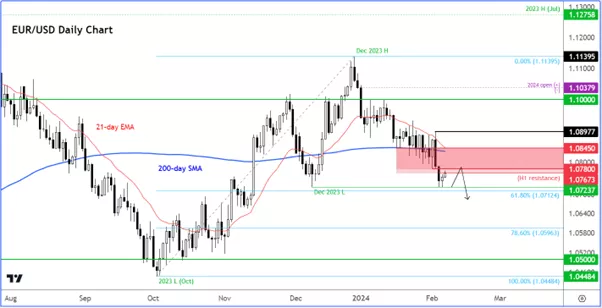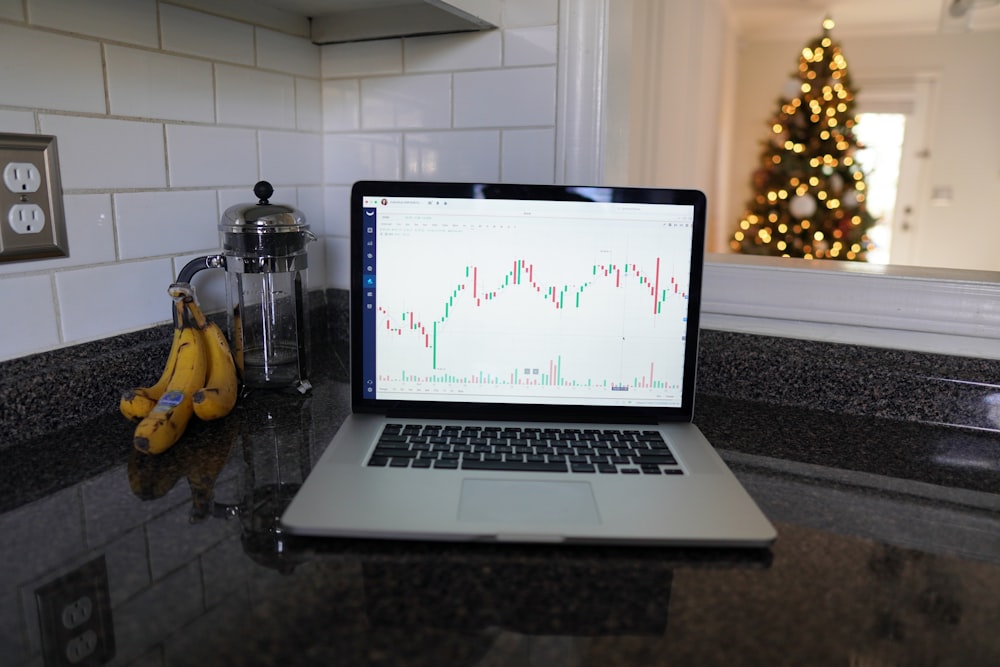EUR/USD: How Low Can Euro Go?
Image Source: Unsplash
The EUR/USD remains in a downtrend, although a light economic calendar means traders are in no hurry to exert significant pressure in either direction, as expectations of early easing from the Fed ebb and flow.
There was some relief in the dollar rally on Tuesday as bond yields fell back, although with little fundamental justification. The retreat came after the Dollar Index had further extended its gains on Monday following a stronger ISM services PMI print, which merely contributed to the perception that the Federal Reserve wouldn't rush to ease policy, following Friday’s robust jobs report.
We have also heard more hawkish talk from Fed officials in recent days including from Cleveland Fed President Loretta Mester and Fed Chairman Jerome Powell, both acknowledging that the Fed is wary of cutting interest rates too soon. The employment report, in particular, has effectively quashed talks of an imminent interest rate reduction.
So, I reckon the dollar will continue to find buyers on any short-term dips until something changes fundamentally. This should keep the pressure on the EUR/USD, despite its slight recovery.
Meanwhile, the euro continues to struggle to hold onto any gains, held back by consistently weak data from the Eurozone. This week, we have seen Eurozone retail sales disappoint at -1.1% month-on-month vs. -0.9% eyed, while German Industrial Production came in well below expectations at -1.6% m/m in December, once again highlighting the struggles of the Eurozone’s economic powerhouse. In the year, industrial production was down 3% and well below its pre-pandemic levels. That said, we also saw surprising strength in German Factory Orders, which rose a solid 8.9% m/m compared to a small decline expected.
EUR/USD technical analysis
The US dollar’s growing strength in recent weeks strongly point to the EUR to USD rate taking out its December low of 1.0723 in due course. On Tuesday, though, the EUR/USD formed a small bullish inside pattern formation as the shorts took profit near the December low. This pattern may seem to be a bullish pattern, but it is often one that traps the bulls when formed inside a bearish trend, which may well be the case this time.
At the time of writing, the EUR/USD had broken above Tuesday’s range, but it was now testing a key resistance zone starting around 1.0767 which was an intra-day support level on Monday before it gave way (you won’t be able to see it on the daily time frame).
The key resistance on the daily time frame comes in the area between 1.0780 to 1.0845. The lower end of this range marks the low of Thursday, which was taken out following a strong US nonfarm payrolls report the following day. The upper end of the range is where the 200-day moving average comes into play.

Source: TradingView.com
How to trade the EUR/USD?
Given the underlying bearish momentum, I would favor using the rebound we have seen on Tuesday and the early parts of Wednesday as an opportunity to get on board the short side, rather than view the bounce back as a double bottom play.
While it is possible the EUR/USD may have formed a double bottom against December’s low of 1.0723, there’s little fundamental justification for the dollar to start trending lower in light of the recent data surprises and hawkish Fed commentary.
So, instead, I think that the EUR/USD, having probed liquidity above Tuesday’s range (buy stops), it may now go on to sweep liquidity resting below Tuesday’s range (sell stops). Remember, the market is a function of liquidity. It moves from one area of liquidity to the next.
So, if the downtrend resumes, then the most obvious downside target for the bears is the liquidity resting below the Tuesday and December lows at 1.0723. Bullish traders playing the double-bottom trade may well have placed their stops there.
Should we break that level, the subsequent short-term target could be the 61.8% Fibonacci retracement level at 1.0712 or more likely the 1.07 handle.
Below these levels, 1.0600 could be the next key level to watch, where the 78.6% Fibonacci retracement also converges.
As things stand, I would only entertain bullish trades on the EUR/USD if we see a clear bullish reversal pattern emerge. This could be formed, for example, once the December low is swept and we see a quick rejection and a nice bounce. Otherwise, a potential breakback above the most recent high at just below the 1.09 handle would invalidate this bearish EUR/USD trend.
More By This Author:
Currency Pair Of The Week: USD/CAD - Tuesday, February 2Nasdaq Rally Suffers Blow, But All Is Not Lost
EUR/USD Finds Some Respite As Focus Shifts To FOMC




